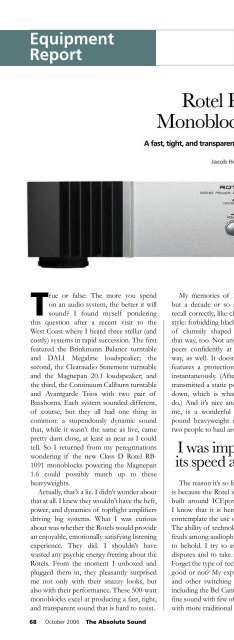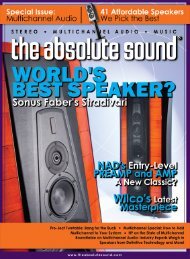Create successful ePaper yourself
Turn your PDF publications into a flip-book with our unique Google optimized e-Paper software.
Equipment<br />
Report<br />
Rotel RB-1091<br />
Monoblock Amplifier<br />
A fast, tight, and transparent sound that is hard to resist<br />
Jacob Heilbrunn<br />
True or false: The more you spend<br />
on an audio system, the better it will<br />
sound I found myself pondering<br />
this question after a recent visit to the<br />
West Coast where I heard three stellar (and<br />
costly) systems in rapid succession. The first<br />
featured the Brinkmann Balance turntable<br />
and DALI Megaline loudspeaker; the<br />
second, the Clearaudio Statement turntable<br />
and the Magnepan 20.1 loudspeaker; and<br />
the third, the Continuum Caliburn turntable<br />
and Avantgarde Trios with two pair of<br />
Basshorns. Each system sounded different,<br />
of course, but they all had one thing in<br />
common: a stupendously dynamic sound<br />
that, while it wasn’t the same as live, came<br />
pretty darn close, at least as near as I could<br />
tell. So I returned from my peregrinations<br />
wondering if the new Class D Rotel RB-<br />
1091 monoblocks powering the Magnepan<br />
1.6 could possibly match up to these<br />
heavyweights.<br />
Actually, that’s a lie. I didn’t wonder about<br />
that at all. I knew they wouldn’t have the heft,<br />
power, and dynamics of topflight amplifiers<br />
driving big systems. What I was curious<br />
about was whether the Rotels would provide<br />
an enjoyable, emotionally satisfying listening<br />
experience. They did. I shouldn’t have<br />
wasted any psychic energy fretting about the<br />
Rotels. From the moment I unboxed and<br />
plugged them in, they pleasantly surprised<br />
me not only with their snazzy looks, but<br />
also with their performance. These 500-watt<br />
monoblocks excel at producing a fast, tight,<br />
and transparent sound that is hard to resist.<br />
68 October 2006 The Absolute Sound<br />
My memories of Rotel are rather hazy,<br />
but a decade or so ago they looked, if I<br />
recall correctly, like clunkers. You know the<br />
style: forbidding black faceplate and a hunk<br />
of clumsily shaped steel. They sounded<br />
that way, too. Not anymore. The new Rotel<br />
peers confidently at you. It behaves that<br />
way, as well. It doesn’t emit much heat. It<br />
features a protection circuit that operates<br />
instantaneously. (After my active crossover<br />
transmitted a static pop, the amplifiers shut<br />
down, which is what they’re supposed to<br />
do.) And it’s nice and light, which, believe<br />
me, is a wonderful contrast to the 200-<br />
pound heavyweight monsters that require<br />
two people to haul around.<br />
I was impressed by<br />
its speed and clarity<br />
The reason it’s so light but fairly powerful<br />
is because the Rotel is a switching amplifier<br />
built around ICEpower technology. Now,<br />
I know that it is heresy in some circles to<br />
contemplate the use of a Class D amplifier.<br />
The ability of technology to evoke spats and<br />
feuds among audiophiles is really something<br />
to behold. I try to avoid these internecine<br />
disputes and to take a more Catholic view:<br />
Forget the type of technology; does it sound<br />
good or not My experience with the Rotel<br />
and other switching amplifiers I’ve heard,<br />
including the Bel Canto, is that they produce<br />
fine sound with few of the hassles associated<br />
with more traditional amplifiers.<br />
Initially, I ran the Rotels on the bass panel<br />
of the Magnepan 20.1. I usually run the<br />
bass panel off a Marchand XM-44 active<br />
crossover, which allows me to bypass the<br />
big capacitors and enormous inductors<br />
in the passive crossover that drag down<br />
its performance. The Rotels performed<br />
admirably; while they didn’t have the<br />
refulgence of the VTL-750s, the Rotels<br />
produced a taut and controlled sound.<br />
These demure monoblocks had no difficulty<br />
powering the bass panels and, consistent with<br />
a switching amplifier, produced little heat, a<br />
marked contrast to the VTLs, which have<br />
a penchant for turning the area around my<br />
loudspeakers into a miniature sauna, which<br />
is nice in wintertime but daunting during the<br />
summer. (Incidentally, given the rising cost<br />
of electricity, not to mention preserving the<br />
environment, the minimal energy use of the<br />
Rotels is nothing to sneeze at.)<br />
Their performance on the bass panel of<br />
the big Maggies whetted my appetite to hear<br />
them on the 1.6, the kind of loudspeaker<br />
they were intended to drive. Once again,<br />
I have to confess that I was taken aback.<br />
Maybe it’s just prejudice, but I was halfexpecting<br />
a wispy, perhaps inchoate sound.<br />
It never happened.<br />
Right off the bat, I was impressed by the<br />
speed and clarity of the amplifiers. On Waltz<br />
for Debby [Analogue Productions SACD],<br />
Bill Evans’ piano came through with great<br />
clarity, and on the song “Who Cares” the<br />
Rotels did an exemplary job of conveying<br />
the jauntiness of Cannonball Adderley’s alto










